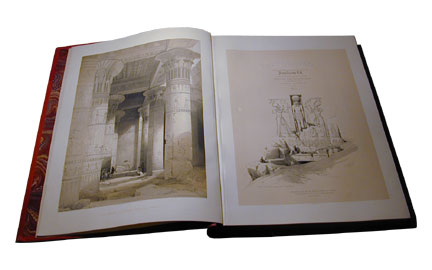

An accompanying text was to be produced which would provide general background on the areas portrayed, and specific descriptions and information of interest for each print. Roberts was not expected to provide this text, but his journal of the trip would be available to the writer as resource material. Moon settled on the Rev. George Croley to provide the text for the Holy Land series, and William Brockedon for the Egypt & Nubia series. Roberts did not think highly of the text produced by either. Both authors' writings convey strong convictions of Victorian moral superiority, but in the end it was the images, not the text, which brought fame to the publication.
Completion of the Holy Land series came first, with the first portion of this set finished in April of 1842. As each group of six lithographs was completed, the RSE colored versions were sent out to the subscribers, mounted on cards, with the accompanying text provided on separate pages. At the same time the SE versions were printed with the text on the pages themselves, appearing on the front of a page below the described half folio, and on the back of that same half folio image to describe the facing full folio print. Both versions were thus set up so that they could be bound into books with both text and images, while the RSE subscription prints could also be kept loose on their cards. (See "How to Identify Different Editions" for photos of both formats.)
By 1845 all of the prints for the Holy Land set had been issued, configured so they could be bound into two large volumes, each with its own title page image. Publication then began for the Egypt & Nubia set, to be completed in 1849. The publisher produced only loose pages, not bound volumes. Customers would take their purchased pages or RSE cards to a bookbinder to have them custom bound. The quality of the binding varied from high to quite modest. As publication of the Egypt & Nubia set proceeded, Moon received comments that the two earlier Holy Land volumes were quite large and heavy, and so the decision was made to publish the Egypt & Nubia set in three volumes, not two. At the same time a third Title Page (of Petra) was produced for the earlier Holy Land set, so as to allow new complete sets to be produced with six thinner, lighter volumes, each with its own title page. Thus there are six Title Pages, one for each potential volume. In some cases earlier customers who already had two-volume Holy Land sets purchased the Egypt & Nubia pages and had them bound in two volumes, not three, to match their Holy Land set (with one volume containing two Egypt & Nubia Title Pages.). Conversely, some Holy Land sets were re-bound (or produced new by Moon as demand dictated) in three volumes, with the new Petra Title Page for the third volume, so as to match accompanying three volume Egypt & Nubia sets. The result is a wide array of bound book formats, with some in four volume sets with five Title Pages, some in four volume sets with six Title Pages, some in five volume sets (i.e. one two volume and one three volume component), and some in six volume sets. All very confusing, but the principal variation is that number of prints within each bound volume varies, the third Holy Land Title Page of Petra may or may not be included, and the frontispiece images and the tables of contents may in some cases appear in the middle of a bound volume. Displayed below is one volume from a high quality SE Egypt & Nubia set, done in two bound volumes, showing the View from under the Portico of the Temple of Philae Frontispiece, and the Aboo Simbel Title Vignette.

It is a source of some confusion as to how many prints were actually produced. The number of RSE sets is theoretically established at 393, based on the original list of subscribers, though Moon may well have produced at least some additional RSE sets as the publication continued over the years. The number of SE sets was certainly higher, as they were produced throughout the period of publication, but the exact number is hard to know - certainly over 500, probably less than 1,500. Ultimately Moon's final stock of unsold prints was auctioned off when the publisher went out of business, and the stones were intentionally destroyed or defaced at that time in an effort to increase the value of the prints being auctioned. The existing prints thus became part of a limited edition, whose precise size is unknown, since the lithographs were not numbered as they were produced, and no records survive from the publisher as to the extent of production.